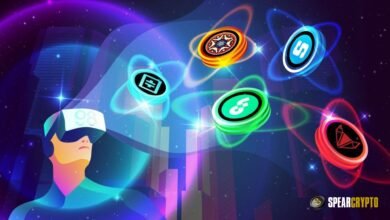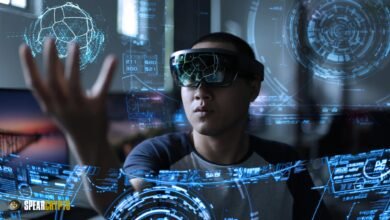
The concept of a “metaverse” that integrates AR and VR has been gaining traction in conversations about the future of digital engagement. The metaverse is a vast, linked digital realm where people can have virtual social interactions and do virtual commerce. “Metaverse spatial,” which encompasses the creation, administration, and utilization of virtual environments inside the metaverse, is an essential part of this rapidly expanding digital realm. Discover the most recent advancements in metaverse spatial and how they affect technology, businesses, and society in this in-depth essay.
Metaverse spatial involves the creation and management of virtual environments within the metaverse. This includes everything from virtual real estate to interactive elements that populate these digital spaces. The goal is to create immersive, engaging experiences that mimic or enhance real-world interactions. As the metaverse evolves, so does the sophistication of spatial design, incorporating advanced technologies like spatial computing, 3D modeling, and artificial intelligence (AI) to craft increasingly realistic and functional virtual environments.
Key Components of Metaverse Spatial
- Virtual Real Estate: Just as physical land is bought and sold in the real world, virtual real estate is a crucial aspect of metaverse spatial. Virtual land parcels can be developed, rented, or sold, creating new economic opportunities and models within the Metaverse spatial.
- Spatial Computing uses technologies that enable digital objects and spaces to interact with the physical world. Spatial computing blends augmented reality (AR), virtual reality (VR), and mixed reality (MR) to create seamless interactions between real and virtual environments.
- 3D Modeling and Design: Creating compelling virtual spaces requires advanced 3D modeling and design techniques. These models must be detailed and interactive, allowing users to navigate and interact with the environment meaningfully.
- Artificial Intelligence: AI plays a significant role in enhancing user experiences within the Metaverse spatial. From generating dynamic content to personalizing interactions, AI technologies help make virtual spaces more engaging and responsive.
Recent Developments in Metaverse Spatial
Enhanced Virtual Real Estate Platforms
Platform developments have facilitated the purchase, sale, and development of virtual real estate in the past few years. Leading companies in this field that allow people to own and create virtual land include Somnium Field, The Sandbox, and Decentraland. These platforms have developed new capabilities, like integrated marketplaces for digital assets, sophisticated personalization tools, and real-time property appraisal.
One example is Decentraland, a virtual world where users can vote on major changes using a decentralized government paradigm. In keeping with the metaverse’s larger philosophy of decentralization, this participative method promotes an atmosphere more driven by the community.
Integration of Spatial Computing
With the advancement of spatial computing technology, more realistic and engaging virtual worlds are becoming possible. By combining AR and VR, consumers can engage with digital components more organically and intuitively. For instance, augmented reality apps can superimpose digital data onto real-world items, and virtual reality settings can create lifelike simulations of entire universes.
New interfaces and interaction models are also being developed due to advancements in spatial computing. For instance, technologies that track the user’s eyes and hands are paving the way for finer-grained control in virtual environments. These advancements in technology are improving the quality of spatial design in the metaverse and making it possible to create experiences that are more immersive and engaging.
Innovations in 3D Modeling
Thanks to the ever-improving state of 3D modeling and design software, artists can now create virtual worlds that are both realistic and interactive. At the front of this innovation are powerful tools for creating immersive 3D experiences, such as Unreal Engine and Unity.
It is also worth noting the recent advances in procedural generation. Massive, intricate virtual worlds can be built using procedural generation techniques with little to no human involvement. In addition to reducing development time, this method enables the production of one-of-a-kind, ever-changing habitats.
AI-Driven Personalization
Artificial intelligence is key in making metaverse experiences unique for each user. Algorithms powered by AI can study user activities and preferences to personalize experiences and information. For instance, AI-powered avatars can imitate human motions and reactions, making virtual interactions more lifelike.
Another use of AI is the development of interactive and adaptable spaces. By considering individual and group feedback, virtual places can modify aspects like lighting, atmosphere, and even the physical layout to suit users better.
Implications for Business and Society
Economic Opportunities
Businesses and entrepreneurs can take advantage of new economic prospects brought about by the growth of metaverse spatial. Some virtual real estate tracts are selling for big bucks, proving that virtual real estate is a major investment asset. In the metaverse, companies may also set up virtual shops, hold events, and design branded experiences.
Digital advertising and marketing also find new opportunities in the metaverse. Businesses can connect with audiences in new and exciting ways by creating interactive and immersive campaigns. As the metaverse develops further, this change towards experiential marketing is predicted to gain significant traction.
Social Interaction and Community Building
Metaverse spatial could revolutionize how people connect and form communities. Individuals can cooperate and connect through virtual worlds regardless of their physical location. This has ramifications for our professional and personal relationships since virtual spaces allow us to work remotely, learn online, and meet up with friends and family.
On the other hand, concerns regarding safety and privacy are brought up by the metaverse. Strong safeguards must be implemented to prevent unauthorized access to sensitive user information and guarantee the safety of all interactions when people engage in virtual spaces. If we want people to trust metaverse technologies and use them wisely, we must address these problems.
Cultural and Creative Expression
There are new possibilities for creative and artistic expression in the metaverse. Artists, designers, and makers can explore innovative means of showcasing work in virtual settings. The metaverse offers a platform for collaborative and experimental art forms, including virtual art galleries.
In addition, the metaverse can make sharing and preserving antiques easier. Historical sites, objects, and traditions can be brought to life in virtual surroundings, allowing them to be enjoyed by people all over the world. Cultural understanding and respect may be fostered via this metaverse feature.
Challenges and Considerations
Technological Limitations
Despite significant advancements, there are still technological limitations to overcome. Issues such as latency, bandwidth, and hardware constraints can impact the quality of metaverse experiences. Ensuring virtual environments run smoothly and seamlessly across various devices will be crucial for widespread adoption.
Ethical and Regulatory Issues
The metaverse introduces a range of ethical and regulatory challenges. Data privacy, intellectual property, and digital rights issues must be addressed to ensure a fair and equitable digital space. Additionally, regulatory frameworks may need to be developed to govern virtual transactions and interactions.
Accessibility and Inclusivity
Ensuring that the metaverse is accessible and inclusive is a key consideration. Efforts must be made to accommodate users with diverse needs and backgrounds, including those with disabilities. Designing virtual environments that are accessible to all will be essential for fostering an inclusive and equitable digital space.
Conclusion
The metaverse spatial is the cutting edge of virtual reality, constantly changing and expanding. Increasingly advanced and immersive virtual environments present new possibilities for interaction, creativity, and economic growth. More interactive and tailored experiences are on the horizon because of developments in this field spurred by the convergence of technologies like spatial computing, 3D modeling, and AI.
Nevertheless, there are obstacles to overcome in advancing metaverse spatial, such as concerns about accessibility, ethical implications, and technological limits. We can create a digital future that is welcoming, creative, and interesting by meeting these obstacles head-on and taking advantage of what the metaverse has to offer.
To fully grasp the potential of this fascinating new digital frontier, it is vital to keep an eye on developing trends and technologies as we continue to investigate and expand metaverse spatial. Rather than being a theoretical concept, the metaverse is already here and can potentially revolutionize our daily lives in the digital era.
[sp_easyaccordion id=”3036″]






